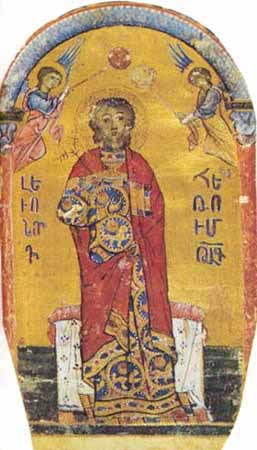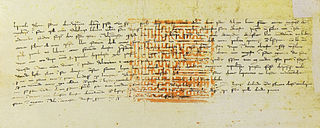Related Research Articles

Leo IV or Leon IV was the last Hethumid king of Cilicia, ruling from 1320 until his death. He was the son of Oshin of Armenia and Isabel of Korikos, and came to the throne on the death of his father. His name is sometimes spelled as Leo or Leon.

Hethum I ruled the Armenian Kingdom of Cilicia from 1226 to 1270. He was the son of Constantine of Baberon and Princess Alix Pahlavouni of Lampron and was the founder of the dynasty which bears his name: the Hethumids also known as the House of Lampron. Having accepted the suzerainty of the Mongol Empire, Hethum himself traveled to the Mongol court in Karakorum, Mongolia, a famous account of which is given by Hethum's companion, the historian Kirakos Gandzaketsi, in his History of Armenia. He allied with the Mongols to fight against the Muslim Mamluks and also encouraged other Crusader states to do the same.

Leo II or Leon II was king of the Armenian Kingdom of Cilicia, ruling from 1269/1270 to 1289. He was the son of King Hetoum I and Queen Isabella and was a member of the House of Lampron.

Hethum II, also known by several other romanizations, was king of the Armenian Kingdom of Cilicia, ruling from 1289 to 1293, 1295 to 1296 and 1299 to 1303, while Armenia was a subject state of the Mongol Empire. He abdicated twice in order to take vows in the Franciscan order, while still remaining the power behind the throne as "Grand Baron of Armenia" and later as Regent for his nephew. He was the son of Leo II of Armenia and Kyranna de Lampron, and was part of the Hethumid dynasty, being the grandson of Hethum I, who had originally submitted Cilicia to the Mongols in 1247. He was assassinated with his nephew and successor Leo III by the Mongol general Bilarghu, who himself was later executed for this by the Mongol Ilkhan ruler Öljaitü.
Leo III Armenian: Լեւոն Գ, Levon III) (occasionally numbered Leo IV; was a young king of the Armenian Kingdom of Cilicia, ruling from 1303 or 1305 to 1307, along with his uncle Hethum II. A member of the Hethumid dynasty, he was the son of Thoros III of Armenia and Margaret of Lusignan, who was the daughter of King Hugh III of Cyprus.

Smbat was king of the Armenian Kingdom of Cilicia, ruling from 1296 to 1298. He was the son of Leo II of Armenia and Kyranna de Lampron and was part of the Hetoumid-family.
Bohemond VI, also known as the Fair, was the prince of Antioch and count of Tripoli from 1251 until his death. He ruled while Antioch was caught between the warring Mongol Empire and Mamluk Sultanate. He allied with the Mongols against the Muslim Mamluks and his Crusaders fought alongside the Mongols in their battles against the Mamluks. The Mamluks would achieve a historic victory against the Mongols and halt their advance westwards at the Battle of Ain Jalut. In 1268 Antioch was captured by the Mamluks under Baybars, and he was thenceforth a prince in exile. He was succeeded by his son, Bohemond VII.

The Armenian Kingdom of Cilicia, also known as Cilician Armenia, Lesser Armenia, Little Armenia or New Armenia, and formerly known as the Armenian Principality of Cilicia, was an Armenian state formed during the High Middle Ages by Armenian refugees fleeing the Seljuk invasion of Armenia. Located outside the Armenian Highlands and distinct from the Kingdom of Armenia of antiquity, it was centered in the Cilicia region northwest of the Gulf of Alexandretta.
Kitbuqa Noyan, also spelled Kitbogha, Kitboga, or Ketbugha, was an Eastern Christian of the Naimans, a group that was subservient to the Mongol Empire. He was a lieutenant and confidant of the Mongol Ilkhan Hulagu, assisting him in his conquests in the Middle East and massive destruction of Baghdad and massacre of innocent citizens. When Hulagu took the bulk of his forces back with him to attend a ceremony in Mongolia, Kitbuqa was left in control of Syria, and was responsible for further Mongol raids southwards towards the Mamluk Sultanate based in Cairo. He was killed at the Battle of Ain Jalut in 1260.

Mahmud Ghazan was the seventh ruler of the Mongol Empire's Ilkhanate division in modern-day Iran from 1295 to 1304. He was the son of Arghun, grandson of Abaqa Khan and great-grandson of Hulagu Khan, continuing a long line of rulers who were direct descendants of Genghis Khan. Considered the most prominent of the Ilkhans, he is perhaps best known for converting to Islam and meeting Imam Ibn Taymiyya in 1295 when he took the throne, marking a turning point for the dominant religion of the Mongols in Western Asia. One of his many principal wives was Kököchin, a Mongol princess sent by his great-uncle Kublai Khan.

Starting in the 1240s, the Mongols made repeated invasions of Syria or attempts thereof. Most failed, but they did have some success in 1260 and 1300, capturing Aleppo and Damascus and destroying the Ayyubid dynasty. The Mongols were forced to retreat within months each time by other forces in the area, primarily the Egyptian Mamluks. Since 1260, it had been described as the Mamluk–Ilkhanid War.

Hayton of Corycus was a medieval Armenian nobleman, monk and historiographer.

Buscarello de Ghizolfi, or Buscarel of Gisolfe, was a European who settled in Persia in the 13th century while it was part of the Mongol Ilkhanate. He was a Mongol ambassador to Europe from 1289 to 1305, serving the Mongol rulers Arghun, Ghazan and then Oljeitu. The goal of the communications was to form a Franco-Mongol alliance between the Mongols and the Europeans against the Muslims, but despite many back and forth communications, the attempts were never successful.

Several attempts at a Franco-Mongol alliance against the Islamic caliphates, their common enemy, were made by various leaders among the Frankish Crusaders and the Mongol Empire in the 13th century. Such an alliance might have seemed an obvious choice: the Mongols were already sympathetic to Christianity, given the presence of many influential Nestorian Christians in the Mongol court. The Franks were open to the idea of support from the East, in part owing to the long-running legend of the mythical Prester John, an Eastern king in an Eastern kingdom who many believed would one day come to the assistance of the Crusaders in the Holy Land. The Franks and Mongols also shared a common enemy in the Muslims. However, despite many messages, gifts, and emissaries over the course of several decades, the often-proposed alliance never came to fruition.

Sempad the Constable (1208–1276) was a noble in Cilician Armenia, an older brother of King Hetoum I. He was an important figure in Cilicia, acting as a diplomat, judge, and military officer, holding the title of Constable or Sparapet, supreme commander of the Armenian armed forces. He was also a writer and translator, especially known for providing translations of various legal codes, and the creation of an important account of Cilician history, the Chronique du Royaume de Petite Armenie. He organized and fought in multiple battles, such as the Battle of Mari, and was trusted by his brother King Hetoum to be a key negotiator with the Mongol Empire.

The Battle of Mari, also called the Disaster of Mari, was a battle between the Mamluk Sultanate of Egypt and the Armenians of Cilician Armenia on 24 August 1266.
Kutlushah, Kutlusha or Qutlughshah, was a general under the Mongol Ilkhanate ruler Ghazan at the end the 13th century. He was particularly active in the Christian country of Georgia and especially during the Mongol invasion of Syria, until his ignominious defeat in 1303 led to his banishment. He was killed during the conquest of Gilan in 1307.
Nerses Balients, also Nerses Balienc or Nerses Bagh'on, was a Christian Armenian monk of the early 14th century. He is mainly known for writing a history of the Kingdom of Cilician Armenia. Though his works are regarded by modern scholars as a valuable source from the time period, they are also regarded as frequently unreliable.

The Second Battle of Sarvandik'ar was fought in 1276 A.D. between an army of the Mamluks of Egypt and a unit of Cilician Armenians, in a mountain pass that separates Eastern Cilicia and Northern Syria. The battle was part of the Armenian war effort against a much larger and better trained army that habitually raided the Cilician Plain and threatened to annihilate the Armenian Kingdom of Cilicia.

Mongol Armenia or Ilkhanid Armenia refers to the period in which both Armenia and the Armenian Kingdom of Cilicia became tributary and vassal to the Mongol Empire in the 1230s. Armenia and Cilicia remained under Mongol influence until around 1335.
References
- Claude Mutafian, Le Royaume Arménien de Cilicie
- Recueil des historiens des Croisades, Documents Arméniens I, 14th century.